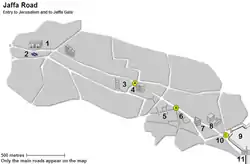Zion Square
Zion Square (Hebrew: כיכר ציון, Kikar Tziyon) is a public square in Jerusalem, located at the intersection of Jaffa Road, Ben Yehuda Street, Herbert Samuel Street, and Yoel Moshe Salomon Street.
| Zion Square | |
|---|---|
| Public square | |
| Kikar Zion | |
 Zion Square during the daytime (looking towards Ben Yehuda Street) | |
| Location | Intersection of Jaffa Road, Ben Yehuda Street, Herbert Samuel Street, and Yoel Moshe Salomon Street Jerusalem |
| Coordinates: 31°46′55.2″N 35°13′10.6″E | |
The square is one of the vertices of the Downtown Triangle commercial district. Since the British Mandate era, Zion Square has been the focal point of the cultural life of downtown Jerusalem. The square is busy day and night with tourists, elderly immigrants, overseas students, local youth, street performers, and religious activists. In recent decades, the square has become a hangout for disaffected and homeless youth.
From the 1930s to 2011, the square was a popular site for mass protests and demonstrations.
Name
._matpc.20999.jpg.webp)
The square, originally called Zion Circus,[1] was named for the Zion Cinema[2][3] (also called Zion Hall), a 400-seat silent movie house which occupied a hut on the site from 1912 to 1920. After the hut collapsed under a heavy snowfall, the cinema was reconstructed as a 600-seat theater for film screenings and live opera performances.[2]
History
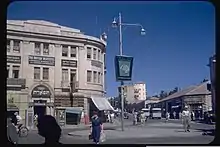
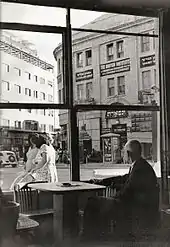
The land on which Zion Square and the Downtown Triangle lies was purchased by the Jewish Colonization Association from the Greek Orthodox Patriarchate,[4] which began selling off some of its holdings in Jerusalem after World War I.[5] Mandate officials developed the field into a triangular district bordered by Jaffa Road, Ben Yehuda Street (constructed by the British in 1922) and King George Street (constructed by the British in 1924).[6] Zion Square was also designed by the British[7] as a roundabout.
The popularity of the films, operas, plays, concerts and lectures presented at the Zion Cinema turned Zion Square into the “center of cultural life in Jerusalem” in the 1920s and 1930s.[4] Movie- and theater-goers gravitated between the cinema and the many cafes and coffee houses in the Downtown Triangle; two of the popular cafes were located in Zion Square itself: the Vienna Cafe[8] and the Europa Cafe.[9]
Political demonstrations
Zion Square became a rallying point for political demonstrations and social protests beginning in the 1930s, when young Zionists held rallies here.[10] From the 1950s to the 2000s, primarily right-wing demonstrations were staged here.[2][11] Several demonstrations turned violent, such as a 1971 protest by the Israeli Black Panthers in which Prime Minister Golda Meir was burned in effigy,[12] and a 1995 protest against Prime Minister Yitzhak Rabin and the signing of the Taba Agreement (Oslo II), after which thousands of protesters continued on to the Knesset, destroying property en route.[13] The largest demonstrations in the square included a May 2000 protest decrying the handover of Arab settlements adjacent to the Mount of Olives,[14][15] a November 2000 protest against Ehud Barak's "policy of restraint" at the beginning of the Second Intifada,[16] and a 2006 protest against the policies of acting prime minister Ehud Olmert,[17][18] each of which drew around an estimated 100,000 people.
With the opening of the Jerusalem Light Rail on Jaffa Road in August 2011, Jerusalem police stopped issuing permits for demonstrations in Zion Square to avoid the disruption of light-rail operations.[19][20]
Terrorist attacks
The Zion Cinema was the site of two attempted bombings, one in 1951 and the other in 1967. In both cases, an incendiary device was planted under the theater seats and was discovered before it detonated.[2][10]
On July 4, 1975, a refrigerator loaded with 5 kilograms (11 lb) of explosives detonated in Zion Square, killing 15 and wounding 77.[21] At the time, the attack was the deadliest ever against Israeli citizens by a booby-trapped bomb.[22] On March 24, 1979, a bomb exploded in a garbage can in Zion Square, killing one and wounding 13.[21]
On the night of August 16–17, 2012, dozens of Jewish teens chased four Palestinian teens in Zion Square and beat one of them unconscious, in what Israeli police and witnesses described as an attempted lynching.[23][24]
Decline and redevelopment
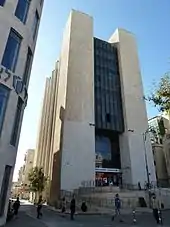
Following the reunification of Jerusalem in 1967, the city embarked on significant expansion. Large commercial centers were opened in the new, outlying neighborhoods of Talpiot, Givat Shaul, and Malha, weaning customers away from the city center. Government offices began moving out as well, precipitating the economic decline of the Downtown Triangle in the 1970s.[25] The advent of television precipitated the closure of most of the Triangle's cinemas.[26] The Zion Cinema closed in 1972 and was demolished.[2] In its place, a high-rise building containing the Kikar Zion Hotel (on the upper floors) and a branch of Bank Hapoalim (on the lower floors) was erected.[2][7]
In 1983 Zion Square was converted into a pedestrian promenade along with Ben Yehuda Street and other streets in the Downtown Triangle in a successful effort to revitalize the downtown district.[6]
In 2006 the Jerusalem Foundation floated a secret proposal to rename the square Rapaport Plaza, after a Waco, Texas philanthropist who pledged $2 million toward the square's renovation.[27] Architect Ron Arad of London was hired and presented a plan to install a towering, red, reflective steel sculpture as a focal point for the square.[27][28] The plan, which was not reported to the public, was spotted on the Jerusalem Foundation website and brought to public attention by Lemallah, a grassroots citizens watch group, which launched a successful public protest against the name change and the sculpture.[27] At the same time, Lemallah produced its own counterproposal for a round, six-sided, steel "peace dome" to span the square and Jaffa Road.[27][29] That idea, too, did not come to fruition.
In early 2016, a contest was held to redesign the square and on September 13, 2016, the Jerusalem Municipality announced that its panel had chosen a design by Maya Atidia and Tamir Manzur-Carmel called "Urban Forest Clearing" as the winner.[30] Redevelopment work began in 2018, with the installation of a stage, public seating, and trees of the plane, carob, Mediterranean hackberry, and pear varieties.[31]
Street scene
Go Jerusalem.com[32]
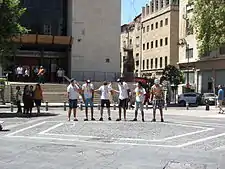
Zion Square is busy day and night as a meeting place and hangout for people from all walks of life, including tourists, elderly immigrants, seminary students, street performers, and Chabad and Breslov activists.[10][33][34] Zion Square has been described as "always crowded, always crazy".[3]
The square is a hangout for drug users. An estimated 70 percent of teenagers who hang out in the square take drugs.[35] The open, street-level basement of the Kikar Zion Hotel is a well-known haunt for both drug dealers and prostitutes.[36]
School dropouts, disaffected religious immigrant teens, and homeless youth are also fixtures in the square.[37] Street workers have identified large groups of Russian immigrant youth hanging out in the square and drinking vodka purchased with money panhandled off tourists.[38] The square also attracts sizable numbers of settlement youth uprooted by the 2005 Israeli disengagement from Gaza.[38] To reach out to at-risk and disaffected "square dwellers", several drop-in centers operate in the vicinity of Zion Square, including Crossroads,[37][39] Hameshulash, Hezroni's Squat, and The Zone.[40] The ELEM – Youth Distress in Israel organization brings a mobile unit to Zion Square on weeknights to engage street youth in art projects.[41]
Landmarks

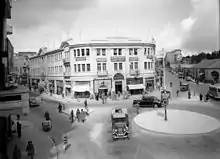
Zion Cinema was the central landmark of Zion Square from the 1920s until its closure in 1972. Located on the south side of Zion Square, it was originally a 400-seat silent-movie hut and, after snowfall destroyed the structure, was rebuilt into a 600-seat theatre[2] that staged plays, concerts, lectures, and films. In the 1920s and 1930s the Zion Cinema was the cultural center of Jerusalem.[4] After its closure, the building was demolished and a high-rise containing the Kikar Zion Hotel and a branch of Bank HaPoalim was erected in its place.[2] In 2013 the 117-room hotel was purchased by Orchid Hotel Management Ltd.,[42] which is renovating the property for reopening as the Herbert Samuel Hotel. The hotel will have 137 rooms and suites, and a kosher rooftop restaurant with a 360-degree panoramic view.[43]
Hamashbir Lazarchan, a seven-story, 5,000 square metres (54,000 sq ft) department store that opened on the east side of Zion Square in 2011, is the largest department store in Israel[44] and the flagship store of the 38-store chain.[45] The store was originally established in 1947 on the opposite side of Jaffa Road, and moved to a location near King George and Ben Yehuda Streets from 1970 to 2010.[45]
On the north side of Zion Square stands the Jerusalem Hostel. This lodging opened as the Tel Aviv Hotel in 1926 and later became known as the Ron Hotel.[7] Menachem Begin stood on one of the hotel's balconies on August 3, 1948, to announce the dissolution of the Irgun and the sign-up of his soldiers with the Israel Defense Forces.[7]
On the west side of Zion Square stands the Sansur Building, erected in 1929.[9] This three-story office and commercial building sports an "eclectic", neo-Renaissance and classical design.[46] The building was commissioned by and named for a Christian Arab merchant from Bethlehem[4] and originally housed Cafe Europe, a popular coffeehouse patronized by Jews, Arabs, and British in the 1930s and 1940s.[9] In 1947-48 it housed the Jerusalem Emergency Committee.[47]
References
Notes
- Glass 2002, p. 289.
- כיכר ציבורית מרכזית בליבהּ של ירושלים ומרכז העסקים הראשי [Central public square in the heart of Jerusalem and the main business center] (in Hebrew). allaboutjerusalem.com. 2014. Retrieved 8 March 2014.
- Barrett 1999, p. 175.
- Wager 1988, p. 227.
- Eisenstadt, David (May 1997). "The British Mandate". Ingeborg Rennert Center for Jerusalem Studies. Retrieved 24 November 2013.
- "The Jerusalem Triangle". Jerusalem.com. 5 July 2013. Retrieved 24 November 2013.
- Bar-Am, Aviva; Bar-Am, Shmuel (24 August 2013). "Haman's Hat: Life in the Jerusalem Triangle". Times of Israel. Retrieved 5 February 2014.
- Glass & Kark, p. 219.
- MacKinnon, Mark (2008). "Israel at 60, a state of shock". The Globe and Mail. Retrieved 28 November 2013.
- Hermann, Peter (27 January 2002). "Mideast ideologies collide on Jerusalem's Jaffa Road". The Baltimore Sun. Retrieved 4 March 2014.
- Ben Ari, Michal (7 December 2007). ניפגש בכיכר [Let's Meet in the Square]. Ynetnews (in Hebrew). Retrieved 9 March 2014.
- Chetrit 2009, pp. 110–111.
- Pedahzur 2012, pp. 148–149.
- Balint 2001, p. 46.
- "Right-Wing Demonstration at Zion Square". Israel Wire. 16 May 2000. Archived from the original on 28 March 2015. Retrieved 21 March 2014. (subscription)
- Gefen 2001, p. 325.
- "Anti-Olmert Rally Brings 100,000 to Zion Square". Crown Heights.info. 5 February 2006. Retrieved 2 March 2014.
- "Anti-Olmert Rally Brings 100,000 to Jerusalem's Zion Square". Israel National News. 6 February 2006. Archived from the original on 28 March 2015. Retrieved 21 March 2014. (subscription)
- Lidman, Melanie (30 May 2012). "J'lem police deny social protesters Zion Square". The Jerusalem Post. Retrieved 2 March 2014.
- Hasson, Nir (29 May 2012). "Jerusalem protesters stopped in their tracks by light rail as Zion Square declared off limits". Haaretz. Retrieved 9 March 2014.
- Sheleg, Yair (3 December 2001). "A Short History of Terror". Haaretz. Retrieved 3 March 2014.
- Hagee 2003, p. 35.
- Davidson, Amy (21 August 2012). "An Attack in Zion Square". The New Yorker. Retrieved 14 March 2014.
- Kershner, Isabel (20 August 2012). "Young Israelis Held in Attack on Arabs". The New York Times.
- Ramon, Amnon; Yelinek, Aviel; Vitman, Asaf (2011). "Downtown Jerusalem: The story of Jerusalem's city center and its regeneration" (PDF). Jerusalem Institute for Israel Studies. p. 5. Retrieved 14 March 2014.
- Kreusa-Israel, Hailit (12 September 2011). פעם היה פה שמח: געגועים למשולש הזהב של ירושלים [Once It Was Happy Here: Nostalgia for the golden triangle of Jerusalem]. Maariv (in Hebrew). Retrieved 14 March 2014.
- Zohar, Gil (2 March 2012). "Kikar Zion saved". The Jerusalem Post. Retrieved 12 March 2014.
- "Zion Square 2006". Ron Arad Architects Ltd. Retrieved 12 March 2014.
- "Zion Square Peace Dome, Jerusalem". YouTube. 19 June 2007. Retrieved 12 March 2014.
- Zazon, Eli (2016-09-13). "Zion Square". Jerusalem Construction News. Retrieved 2016-09-13.
- Nardi, Guy (2 April 2018). "Jerusalem's Zion Square to undergo major facelift". Globes. Retrieved 8 July 2018.
- "Welcome to Zion Square". gojerusalem.com. 2008. Retrieved 2 March 2014.
- Thomas 2010, p. 132.
- "Stepping sideways in Zion Square". jerusalemite.net. 23 July 2008. Retrieved 2 March 2014.
- Mahdī 2003, p. 71.
- Heumann, Gerard (28 September 2012). "There's no 'there' at Jerusalem's Zion Square". Haaretz.
- Bedein, Sara (Fall 2002). "Kikaristim Come Home" (PDF). Jewish Action.
- Ha'Ivri, David (15 October 2006). "The Jerusalem You Do Not Want to Know". Israel National News. Retrieved 3 March 2014.
- Berman, Daphna (21 November 2003). "Zion Square's West Side Story". Haaretz. Retrieved 14 March 2014.
- Ivri, Yael (6 December 2007). "Square-Dwelling Youths". Ynetnews. Retrieved 14 March 2014.
- "At-Risk Youth Project". Israel Museum. 2013. Retrieved 14 March 2014.
- "Nakash Bros buy hotel in Jerusalem's Zion Square for NIS 80m". Globes. 1 September 2013. Retrieved 2 March 2014.
- "מלון הרברט סמואל ירושלים" [Herbert Samuel Hotel Jerusalem] (in Hebrew). herbertsamuel.com. Retrieved 17 December 2015.
- Dvir, Noam (16 September 2011). "A New Consumer Shrine?". Haaretz. Retrieved 18 December 2013.
- Cashman, Greer Fay (2 November 2011). "J'lem: Landmark Hamashbir dept. store gets new location". The Jerusalem Post. Retrieved 24 November 2013.
- "Sansur Building". Israel Land Development Company. Retrieved 28 November 2013.
- Joseph 1960, p. 137.
Sources
- Balint, Judy Lash (2001). Jerusalem Diaries: In Tense Times. Gefen Publishing House Ltd. p. 46. ISBN 9652292710.
kikar zion.
- Barrett, Pam (1999). Insight Guide: Israel (4th ed.). APA Publications. ISBN 0887291570.
- Chetrit, Sami Shalom (2009). Intra-Jewish Conflict in Israel: White Jews, Black Jews. Routledge. ISBN 113520232X.
- Glass, Joseph B.; Kark, Ruth (2007). Sephardi Entrepreneurs in Jerusalem: The Valero Family 1800-1948. Gefen Publishing House Ltd. ISBN 9652293962.
- Hagee, John (2003). The Battle for Jerusalem. Thomas Nelson Inc. ISBN 1418555835.
- Gefen, Aba (2001). Israel at a Crossroads. Gefen Publishing House Ltd. ISBN 9652292591.
- Glass, Joseph B. (2002). From New Zion to Old Zion: American Jewish Immigration and Settlement in Palestine, 1917-1939. Wayne State University Press. ISBN 0814328423.
- Joseph, Dov (1960). The Faithful City: The Siege of Jerusalem, 1948. Simon and Schuster.
- Mahdī, 'Alī Akbar (2003). Teen Life in the Middle East. Greenwood Publishing Group. ISBN 031331893X.
- Pedahzur, Ami (2012). The Triumph of Israel's Radical Right. Oxford University Press. ISBN 0199911347.
- Thomas, Amelia (2010). Israel and the Palestinian Territories. Lonely Planet. p. 132. ISBN 1742203515.
- Wager, Eliyahu (1988). Illustrated Guide To Jerusalem. Jerusalem Publishing House. ISBN 0875592309.
External links
| Wikimedia Commons has media related to Zion Square. |
